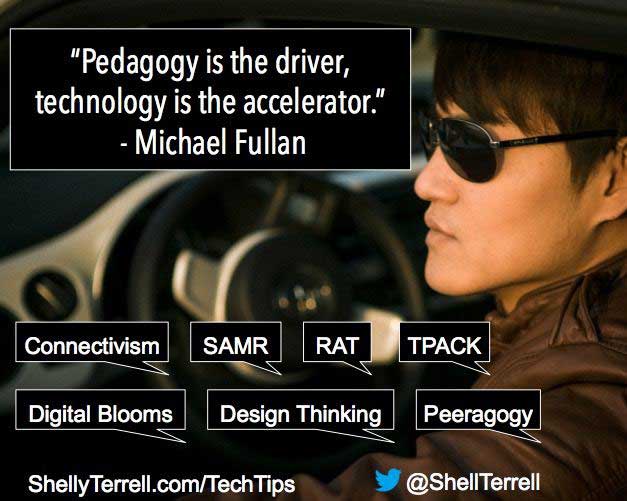7 Digital Learning Theories and Models You Should Know
Knowing these digital learning theories and models can boost your instruction

While pursuing teaching degrees, educators are introduced to various learning theorists and their insights about how people learn best. Some familiar names include Piaget, Bandura, Vygotsky, and Gardner.
Although understanding these learning theories is still important, aspiring educators also need to become familiar with theories, models, and approaches that provide insight on how technology, social media, and the internet impact learning. Digital learning theories and approaches, such as RAT, SAMR, TPACK, Digital Blooms, Connectivism, Design Thinking and Peeragogy help teachers develop curricula that gets students to use technology to research, curate, annotate, create, innovate, problem-solve, collaborate, campaign, reform and think critically. These are skills outlined in Shelly Terrell’s Hacking Digital Learning Strategies with EdTech Missions.
Digital learning approaches consider what students are currently doing online and allow teachers to design curricula to help students gain the digital skills they need to thrive in a digitally connected world.
Below are some useful links to discover more about these approaches.

1. The RAT Model
The RAT model is a way of looking at technology and how it has or has not altered instruction. The “R” stands for replacement, and in this mode of instruction technology is just replacing a previous tool for instruction but in no way changing the instructional practices or learning that occurs. The “A” is amplification, which refers to when class instructional practices remain the same but the use of technology increases the lesson’s efficiency and effectiveness or reach. The “T” is transformation, and is when technology is used to reinvent certain aspects of instruction in new and innovative ways.
2. SAMR
Tech & Learning Newsletter
Tools and ideas to transform education. Sign up below.
The SAMR model stands for substitution, augmentation, modification, and redefinition, and looks at four tiers of tech implementation. Educators frequently have a tendency to focus on the first two tiers, essentially converting previous instructional practices into a technological format: for instance, recording a lecture and posting it online, or posting PDFs of previously printed materials. The second two tiers entail using technology to more fundamentally change instruction.
3. The TPACK Framework
TPACK stands for technological, pedagogical, and content knowledge. The framework examines the interplay of three grouped areas of content knowledge (CK), pedagogy (PK), and technology (TK), and explores the ways these areas intersect. While it is often compared to SAMR, these are quite different models, with TPACK being a less linear way of thinking about incorporating technology into teaching.
Bloom’s Taxonomy was created by Benjamin Bloom and his collaborators in the 1950s as a framework for categorizing educational goals that is often depicted as a pyramid with each level requiring higher levels of thinking in order to achieve mastery. Over time, the original nouns used by Bloom and colleagues were replaced with active verbs. Now at the base of the pyramid is the word remember, and it builds up in order to apply, analyze, evaluate, and create. The new framework has also been updated to incorporate technology.
5. Connectivism
Introduced in 2005 by George Siemens and Stephen Downes, this learning theory holds that students should learn how to combine thoughts, theories, and other information in a useful way. The theory builds on the idea that technology has increased the speed of our access to information, and our constant connectedness should be harnessed to help students make choices about learning, collaborating, and learning from diverse sources, including sources on social media.
6. Design Thinking
Popularized by tech companies, design thinking takes engineering and artistic processes and applies these to other fields, such as education. Using this framework, educators and students can identify challenges, gather information, generate potential solutions, refine ideas, and test solutions. This framework can be helpful for department, school, or team planning, as well as class planning or for individual lessons.
7. Peeragogy
As any educator can tell you, there’s nothing quite like peer learning. Peeragogy, also known as paragogy, is a collection of best practices for peer-to-peer learning that seeks to help educators overcome some of the obstacles to effective peer learning such as peers who don’t produce useful and/or supportive feedback.
Resources
- What is RAT? by developer, Dr. Joan Hughes
- SAMR and Digital Blooms resources by Kathy Schrock
- The Peeragogy Handbook with founder Howard Rheingold
- The TPACK Framework
- Design thinking is a process for creative problem solving
Challenge: Explore one of these digital learning theories to see how you can make at least one change enhance the way you integrate technology.
The original version of this story was cross posted at teacherrebootcamp.com
Shelly Terrell is an education consultant, technology trainer, and author. Read more at teacherrebootcamp.com
Shelly Terrell is an education consultant, technology trainer, and author. Read more at teacherrebootcamp.com
